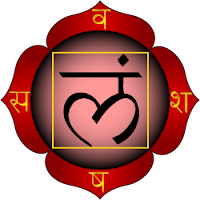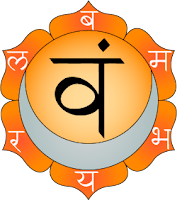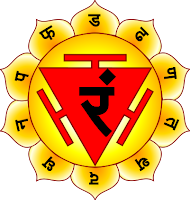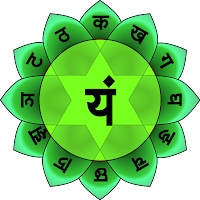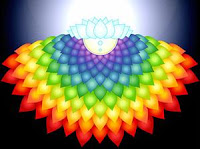Still your mind in me, still yourself in me, and without a doubt you shall be united with me, Lord of Love, dwelling in your heart. -- Bhagavad Gita
---------------------------------------------------------------------------------------------------------------------------------
Chakras are energy centers along the spine located at major branchings of the human nervous system, beginning at the base of the spinal column and moving upward to the top of the skull, through which pass 3 major energy channels, Sushumna, Ida and Pingala. Chakras are considered to be a point or nexus of biophysical energy or prana of the human body. Prana is the basic component of your subtle body, your energy field, and the entire chakra system...the key to life and source of energy in the universe.
The following seven primary chakras are commonly described:
- Muladhara (Sanskrit: मूलाधार, Mūlādhāra) Base or Root Chakra (ovaries/prostate)
- Swadhisthana (Sanskrit: स्वाधिष्ठान, Svādhiṣṭhāna) Sacral Chakra (last bone in spinal cord, the coccyx)
- Manipura (Sanskrit: मणिपूर, Maṇipūra) Solar Plexus Chakra (navel area)
- Anahata (Sanskrit: अनाहत, Anāhata) Heart Chakra (heart area)
- Vishuddha (Sanskrit: विशुद्ध, Viśuddha) Throat Chakra (throat and neck area)
- Ajna (Sanskrit: आज्ञा, Ājñā) Brow or Third Eye Chakra (pineal gland or third eye)
- Sahasrara (Sanskrit: सहस्रार, Sahasrāra) Crown Chakra (top of the head; 'soft spot' of a newborn)
---------------------------------------------------------------------------------------------------------------------------------
Muladhara is said to be located near the basal end of the spinal in the vicinity of the coccygeal plexus beneath the sacrumit, while its kshetram, or superficial activation point, is located on the perineum.
Muladhara is described as a yellow, square lotus, surrounded by 8 shining spears on the sides and corners, and with 4 red petals. The deity of this region is Indra, who is yellow in colour, 4-armed, holding a vajra and blue lotus in his hands, and mounted upon the white elephant Airawata, who has seven trunks, denoting the seven elements vital to physical functioning. Occasionally, instead of Indra, the deity is Ganesha, with coral orange skin, wearing a lemon yellow dhoti with a green silk scarf draped around his shoulders. In his 3 of his hands he holds a ladu, a lotus flower, a hatchet, and the fourth is raised in the mudra of dispelling fear.
Manipura is located at the spine directly behind either the navel or the solar plexus, depending on the system, while its kshetram or superficial activation point is located directly on the navel (or solar plexus).
Anahata is represented by a smoke grey lotus flower, with 12 vermillion petals. Inside of it is a smoke-coloured region that is made from the intersection of 2 triangles, creating a shatkona. The Shatkona is a symbol used in Hindu yantra that represents the union of both the male and feminine form. More specifically it is supposed to represent Purusha (the supreme being), and Prakriti (mother nature, or causal matter). Often this is represented as Shiva - Shakti. The deity of this region is Vayu, who is smoke coloured, four-armed, holding a kusha and riding upon an antelope, the animal of this chakra.

Vishuddha is positioned at the neck region near the spine, with its ksehtram or superficial activation point in the pit of the throat.
The Ajna chakra is positioned in the brain, directly behind the eyebrow centre, while its ksehtram or superficial activation site is at the eyebrow region, in the position of the 'third eye'.
Sahasrara is either located at the top of the head in that one area, or a little way above it (see Sahasrara system of minor chakras below).
Sahasrara is described with 1,000 multi-coloured petals which are arranged in 20 layers each of them with 50 petals. The pericarp is golden, and inside of it is a circular moon region, inside of which is an downward pointing triangle
Ajna is white in colour, with 2 white petals. Inside of the pericarp is the Shakti Hakini, who is moon white, with 6 faces, and 6 arms, holding a book, a skull, a drum, a rosary, and making the gestures of granting boons and dispelling fears. Above her is a downward pointing triangle, within which is a moon-white lingum. In some systems the deity Ardhanarishvara a hermaphrodite form of Shiva-Shakti, symbolising the primordial duality of subject and object, resides within the lingum. Above the triangle is another smaller triangle, within which is the bija mantra Aum.

